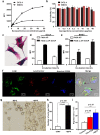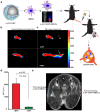Magnetic Enrichment of Dendritic Cell Vaccine in Lymph Node with Fluorescent-Magnetic Nanoparticles Enhanced Cancer Immunotherapy
- PMID: 27698936
- PMCID: PMC5039339
- DOI: 10.7150/thno.15102
Magnetic Enrichment of Dendritic Cell Vaccine in Lymph Node with Fluorescent-Magnetic Nanoparticles Enhanced Cancer Immunotherapy
Abstract
Dendritic cell (DC) migration to the lymph node is a key component of DC-based immunotherapy. However, the DC homing rate to the lymphoid tissues is poor, thus hindering the DC-mediated activation of antigen-specific T cells. Here, we developed a system using fluorescent magnetic nanoparticles (α-AP-fmNPs; loaded with antigen peptide, iron oxide nanoparticles, and indocyanine green) in combination with magnetic pull force (MPF) to successfully manipulate DC migration in vitro and in vivo. α-AP-fmNPs endowed DCs with MPF-responsiveness, antigen presentation, and simultaneous optical and magnetic resonance imaging detectability. We showed for the first time that α-AP-fmNP-loaded DCs were sensitive to MPF, and their migration efficiency could be dramatically improved both in vitro and in vivo through MPF treatment. Due to the enhanced migration of DCs, MPF treatment significantly augmented antitumor efficacy of the nanoparticle-loaded DCs. Therefore, we have developed a biocompatible approach with which to improve the homing efficiency of DCs and subsequent anti-tumor efficacy, and track their migration by multi-modality imaging, with great potential applications for DC-based cancer immunotherapy.
Keywords: DC migration tracking; DC vaccine; antigen delivery; immunotherapy; magnetic targeting..
Conflict of interest statement
The authors declare no competing financial interests.
Figures






Similar articles
-
Different-Sized Gold Nanoparticle Activator/Antigen Increases Dendritic Cells Accumulation in Liver-Draining Lymph Nodes and CD8+ T Cell Responses.ACS Nano. 2016 Feb 23;10(2):2678-92. doi: 10.1021/acsnano.5b07716. Epub 2016 Jan 15. ACS Nano. 2016. PMID: 26771692
-
Superparamagnetic MRI probes for in vivo tracking of dendritic cell migration with a clinical 3 T scanner.Biomaterials. 2015 Jul;58:63-71. doi: 10.1016/j.biomaterials.2015.04.016. Epub 2015 May 4. Biomaterials. 2015. PMID: 25941783
-
Antigen-Loaded Upconversion Nanoparticles for Dendritic Cell Stimulation, Tracking, and Vaccination in Dendritic Cell-Based Immunotherapy.ACS Nano. 2015 Jun 23;9(6):6401-11. doi: 10.1021/acsnano.5b02014. Epub 2015 Jun 3. ACS Nano. 2015. PMID: 26028363
-
Tracking and evaluation of dendritic cell migration by cellular magnetic resonance imaging.Wiley Interdiscip Rev Nanomed Nanobiotechnol. 2013 Sep-Oct;5(5):469-83. doi: 10.1002/wnan.1227. Epub 2013 Apr 30. Wiley Interdiscip Rev Nanomed Nanobiotechnol. 2013. PMID: 23633389 Review.
-
Migration of dendritic cells to the lymph nodes and its enhancement to drive anti-tumor responses.Crit Rev Oncol Hematol. 2016 Nov;107:100-110. doi: 10.1016/j.critrevonc.2016.09.002. Epub 2016 Sep 9. Crit Rev Oncol Hematol. 2016. PMID: 27823637 Review.
Cited by
-
Engineering magnetic nano-manipulators for boosting cancer immunotherapy.J Nanobiotechnology. 2022 Dec 31;20(1):547. doi: 10.1186/s12951-022-01760-8. J Nanobiotechnology. 2022. PMID: 36587223 Free PMC article. Review.
-
T cells loaded with magnetic nanoparticles are retained in peripheral lymph nodes by the application of a magnetic field.J Nanobiotechnology. 2019 Jan 22;17(1):14. doi: 10.1186/s12951-019-0440-z. J Nanobiotechnology. 2019. PMID: 30670029 Free PMC article.
-
Lymph node targeting for immunotherapy.Immunooncol Technol. 2023 Jun 28;20:100395. doi: 10.1016/j.iotech.2023.100395. eCollection 2023 Dec. Immunooncol Technol. 2023. PMID: 37719676 Free PMC article. Review.
-
The enhanced antitumor-specific immune response with mannose- and CpG-ODN-coated liposomes delivering TRP2 peptide.Theranostics. 2018 Feb 12;8(6):1723-1739. doi: 10.7150/thno.22056. eCollection 2018. Theranostics. 2018. PMID: 29556352 Free PMC article.
-
Improving Tumor Retention of Effector Cells in Adoptive Cell Transfer Therapies by Magnetic Targeting.Pharmaceutics. 2020 Aug 27;12(9):812. doi: 10.3390/pharmaceutics12090812. Pharmaceutics. 2020. PMID: 32867162 Free PMC article. Review.
References
-
- Sabado RL, Bhardwaj N. Cancer immunotherapy: dendritic-cell vaccines on the move. Nature. 2015;519:300–1. - PubMed
-
- Tacken PJ, de Vries IJ, Torensma R, Figdor CG. Dendritic-cell immunotherapy: from ex vivo loading to in vivo targeting. Nat Rev Immunol. 2007;7:790–802. - PubMed
-
- van den Ancker W, van Luijn MM, Westers TM, Bontkes HJ, Ruben JM, de Gruijl TD. et al. Recent advances in antigen-loaded dendritic cell-based strategies for treatment of minimal residual disease in acute myeloid leukemia. Immunotherapy. 2010;2:69–83. - PubMed
-
- Zhou FF, Nordquist RE, Chen WR. Photonics immunotherapy — A novel strategy for cancer treatment. J Innov Opt Health Sci. 2016;9:1630001.
-
- Kastenmuller W, Kastenmuller K, Kurts C, Seder RA. Dendritic cell-targeted vaccines-hope or hype? Nat Rev Immunol. 2014;14:705–11. - PubMed
MeSH terms
Substances
LinkOut - more resources
Full Text Sources
Other Literature Sources
Medical
Miscellaneous

